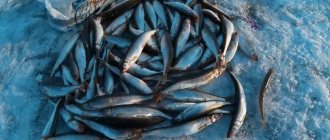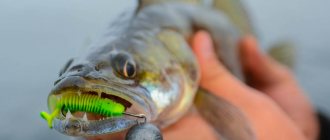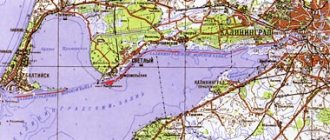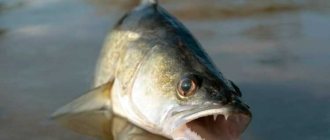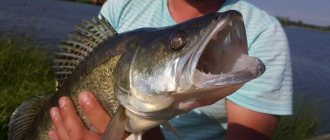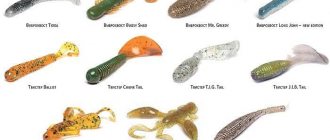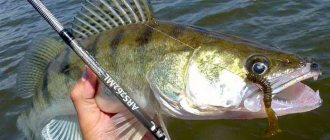Winter pike perch in the Gulf of Finland
Fishing for pike perch is thoughtful, focused and unhurried fishing, and not a mechanical lifting of fish onto the ice (as sometimes happens when catching winter perch), it requires special preparation.
The Gulf of Finland
The area of the Gulf of Finland is 29.5 thousand km². The length of the bay from the Hanko Peninsula to St. Petersburg is 420 km, the width from 70 km at the throat to 130 km at the widest part (on the meridian of Moshchny Island), and in the Neva Bay it decreases to 12 km. The Gulf of Finland is shallow. The profile of the bottom decreases in the direction from the throat to the top. A particularly dramatic change occurs near Ust-Narva, which is why this place is called the Narva Wall. The average depth is 38 m, the maximum depth is 100 m, the depth of the Neva Bay is 6 m or less, and in the coastal strip - up to 1 m. A sea canal has been laid along the bottom of the Neva Bay for the passage of ships. Due to the large influx of fresh water from rivers, especially from the Neva (2/3 of the total flow), the water of the bay has very low salinity. The average water temperature in winter is about 0 °C, in summer 15-17 °C on the surface and 2-3 °C at the bottom. The bay freezes from late November to late April (in warm winters it may not freeze all year round). Freezing begins in the eastern part of the bay and gradually spreads to the west. Characterized by strong wind waves and surges of water during westerly winds, leading to floods)
First pike perch
The first time I caught pike perch in the Gulf of Finland in winter was rather forced, and, by and large, by accident...
In the early 80s, we went to fish for smelt in the town of Peski, known in our area for its treachery and unpredictability, on the northern shore of the Gulf of Finland, about 80 km from St. Petersburg. And the fishing lottery of this place is as follows. On the one hand, good access to the shore, a place to leave a car in the village, and a very sharp drop into the depths made smelt fishing very comfortable, without long and tiring treks. But, on the other hand, if you look at a map of the Gulf of Finland, you will find that Sands in the north, and Cape Gray Horse in the south, form the narrowest place in the Gulf. And, as many years of practice have shown, it is in these areas that unexpected and seemingly unprovoked ice break-ups often occur...
It was not possible to sit down during that fishing trip. Smelt was sometimes caught in pairs, and sometimes in threes - using all jigs on the tackle. Around 11 am, when the bite began to subside a little, there were a couple of bites with the fishing rod being dragged into the hole. When hooking one of them, at first there is a feeling of a hook, and then it turns out that the lower leash is torn. In a word, something incomprehensible was happening under the ice.
We once had a case when, in addition to us, a cod that was large enough for our area decided to hunt for smelt. Several copies of which, with great difficulty and a bunch of fishing rods wound around the fish, were nevertheless managed to be lifted by some lucky ones. This did not happen here - someone stole the bait with complete impunity.
The situation was clarified by one of the venerable fishermen of our company, who still managed to catch a small, about 1 kg, culprit of what was happening with a smelt fishing rod. It was a pike perch!
Reacting to the nods of the smelt fishing rods, I left the fishing rod and spoon on the folding chair. In this position, the spoon was approximately 30-40 cm above the bottom. Once again, when returning to the chair after another bite of smelt, I did not very confidently take the fishing rod with my hand, it slipped out and fell on the ice near the hole. When I picked it up from the ice, I picked it up more confidently and as I lifted it I felt... a clear “hook.” This “hook” very noticeably began to drag the fishing rod into the hole.
Kneeling in front of the hole, carefully picking out the fishing line (0.2 mm) with my fingers, trying to track the slightest tug, I finally recovered a two-kilogram pike perch from a depth of 20 m.
During that memorable fishing trip, we managed to catch another pike perch, but it was smaller.
The main conclusion that I made for myself then was that catching pike perch is a very, very interesting activity that is best done without any combination. Even if these will once be one-off specimens, and often you will be left without a catch at all, but this fishing should be done purposefully.
Fishing times and places
Catching pike perch, for me, is more exciting than catching any other fish from the ice in the North-West. And if in the 80-90s rare fishing took place without catching 2-3 kg of individuals, now a similar result is more of a lottery. The average size has decreased somewhat, but at the same time, it is worth noting that in some years schools of pike perch that come within reach of the shore can be very large. And daily catches of a dozen or even several dozen decent specimens are not uncommon.
In winter, pike perch walks along the coast (both southern and northern), but, as a rule, its capture is often sporadic and random. And mass approaches are observed only in a small number of strictly defined places. The reasons for this phenomenon can be judged only by indirect signs. There is a strong opinion among fishermen that all these approaches are caused, first of all, by the migration of schools of fish that pike perch feed on.
Not always, but very often in places where smelt is excellently caught (especially in early spring) pike perch may be present.
These approaches can last only a few days, or they can be quite long - a school of pike perch remains almost in place for another month.
With such long approaches, the bite may subside for a day, two, or even a week, for some natural or other reasons. And then resume with the same intensity. Moreover, the peak bite time during the day may also undergo noticeable fluctuations.
Where, depending on the condition of the ice, can you catch it with more or less success?
In some years, these may be sections - Strelna - Old Peterhof and a little further, Bolshaya Izhora - Lebyazhye, Krasnoflotsk, Cape Gray Horse and further to Sosnovy Bor and to Cape Kolgompnya - this is along the southern coast. In the north - the places of its approach and fishing can be Olgino, the area of Sestroretsk - Resort, forts and the Tolbukhinsky lighthouse, and Repino-Komarovo, and Zelenogorsk-Ushkovo almost to Primorsk, Vyborg Bay. In most of these places, the bottom of the Gulf of Finland is flat and sandy. There are practically no anomalies or irregularities.
Spoons
About 15-20 years ago, for most fishing trips to the Gulf of Finland, people brought all sorts of “diamonds”, “sleepers”, “triple edges” and a lot of spinners with a length of 80 to 170 mm - a typical “size”, I must say, for that time on the Gulf of Finland » with soldered hooks.
Now the picture has changed a little; spinners with hanging tees have become the most popular. Moreover, not only are not all the spinners from the new assortment widely advertised, each of the fishermen strives to put their own, completely secret tee on them.
What could be a set of such secrets? Of course, I won’t reveal everything; during periods of bad bites my colleagues may beat me up, but I’ll try to highlight the main points, maybe the basics, without knowing which you can go to a pond for years and not see a bite.
Let's start our review of pike perch baits with several photographs from which the “top secret” classification was only recently removed.
"Rhombus".
This rhombus is not quite ordinary - it is missing one face. The development is domestic and has been around for more than 15 years. But about three years ago, Finnish analogues that were very similar in shape, made a little more carefully, appeared on sale. True, I cannot say how catchy the baits of our northern neighbors turned out to be.
Depending on the depth of fishing and the strength of the current, such spoons can be different, both in length and in weight. The spinner's greatest width may be slightly shifted. The craftsmen who make such spoons, due to the unevenness of the filling, can slightly change the position of the center of gravity. The nature of the spinner's movement in the water depends on all these parameters.
But in any case, the decisive component that determines the “catchability” and success of fishing will be the fisherman’s head and hands. The selection and execution of the optimal animation for a given bait depends only on the intuition and skills of the fisherman.
The presented options have proven themselves well at depths ranging from 3.5-4.0 and up to 10-12 m. Brass, copper and technical silver were used as materials in the manufacture of these lures. The small diamond works well where there is no current at depths of up to 6-8 m. The large diamond covers the range from 5 to 12 m in still water and with little current. When talking about currents in the Gulf of Finland, I mean the very low speed of movement of layers of water coming from the Neva and the Saimaa Canal, as well as circulating currents. This speed is small - centimeters per second, but it affects the game of the spinners.
The choice of bait color is also important. In most cases, pike perch are very willing to take on white metals when the spoon is one color (silver, cupronickel, nickel silver or even simple stainless steel).
These lures with hanging hooks are some of the oldest in my collection. Often, in fanged hunting areas, trophy perch are also caught in the by-catch. Several times this lure caught some good bream in such places. Moreover, he didn’t turn purple, but rather “ate” the spoon.
According to their characteristics, they are still more suitable for fishing at depths of up to 7-8 m. For greater depths, other baits are more effective.
"Nautilus".
I tried it on pike perch several years ago, when Finnish spoons had just begun to appear on the market. In my opinion, one of the most interesting, but perhaps also the most difficult spinners to master. It is supplied to the market equipped with a single hook on a chain, which should immediately be replaced with an “equipped” tee (the equipment of which will be discussed below).
The collection includes spinners of this model of different sizes and combinations of metals used. In terms of their size and weight, they are also designed for the entire range of pike perch depths. As practice has shown, the Nautilus 90, primarily due to its weight, shows the most stable performance in the current at the greatest (12-15 m) depths where I have ever caught pike perch. Moreover, it noticeably cuts off small pike perch.
Smaller nautiluses showed excellent results at shallower depths, both for pike perch in the Gulf of Finland and for perch in Lake Ladoga.
"Alaska"
Another innovation of the last 6-7 years. Her single hook suffered the same fate as the Nautilus. In my opinion, one of the most unique spinners. It can work perfectly for both pike perch and pike perch. You just need to choose a game. Taking into account the different depths of application, I also use two standard sizes - 90 and 70 mm - in different colors. But for some reason, pike perch more often choose spinners made only of white metal. And Ladoga perch prefers a combination of red and white metal.
Some homemade products from the early 21st century. I can’t ignore them - on some trips they didn’t just catch fish, they did it very well! True, on some days it felt like they were simply scaring away the pike perch. And as soon as you lowered a branded spoon or balancer into the hole, a bite followed. It is not clear why this happened.
Spoons are named after the object that gave them life.
"Tweezers".
The spoon is made from the handle of a broken tweezers (stainless steel). It has been given a slight additional bend. When fishing at shallow (up to 6-8 m) depths, it sometimes shows simply stunning results. When traveling to Lake Peipus, sometimes it turned out to be the only (!) spinner that the pike perch agreed to bite on. But, unfortunately, I can’t talk about stable fishing in the Gulf of Finland, which is why I put it at the bottom of the list of baits. Also equipped with a hanging hook.
"Spoon".
More precisely, a spoon handle that was slightly processed after testing in the bathroom. Also, in still water it sometimes demonstrates simply miracles of catchability....
And one more, in my opinion, interesting point. For most fishermen, it has become almost an axiom that with increasing fishing depth and increasing current in the fishing area, it is advisable (and in some cases mandatory) to increase the weight and, accordingly, the size of the spoon. During the 3-4 seasons, when the fishing could be said to have taken place, I tried to experiment a little. At depths of more than 8-9 m and with a fairly strong current, when according to all the canons it is necessary to place fairly heavy and large spoons, I tried fishing with an “Alaska” 70 mm long. The result exceeded all my expectations. Pike perch were caught, and they were caught very well, but the only unsatisfactory result of such fishing was the average size of the pike perch.
That is, of the entire catch with this spoon from this depth, I took with me only approximately every fifth pike perch, the rest were sent “to grow.” Moreover, it is quite difficult to release in such a way as to save the life of a pike perch raised from a 9-meter depth. It cannot be removed from the hole, and all release operations had to be done with a long forceps, kneeling over the hole.
When at this depth (on the same hole) I switched to fishing with “Nautilus 90”, all the little things were cut off. Only “food” fish pecked – from 40 cm in length. True, the bites have become noticeably less frequent...
Balance.
Having tried almost the entire line of Rapala and Nils Master. I settled on the following baits (photo).
For these depths, naturally, sizes 7, 8 and 9 are preferable. But sometimes the pike perch begins to be picky, and at these same depths it takes exclusively small baits - 5-6 cm. But there were only two such cases in my practice.
I deliberately put balancers at the end of the list, because after all, the main fishing is with hardware. The hands usually reached the balancers only at the end of fishing, if the “iron” had not received a single poke all morning.
On several extreme fishing trips over the last 2-3 years I tried this tactical technique. I started fishing in the hole with an iron and after 5-7 minutes of unsuccessfully moving the fishing rod, I quickly lowered the balancer there. I won’t say that the method turned out to be 100% working, but I managed to get 4 or 5 bites with such a quick change of baits. Moreover, using this technique in the reverse order (balance - iron) did not help at all. Although, maybe I just didn’t get into the “glue” holes.
Tees.
Many fishermen use tees with a drop of phosphorescent composition on their pike-perch spoons. I usually additionally equip such a tee with an imitation of bloodworm, made of red synthetic fluffy yarn, such as artificial mohair. It is difficult to say what role this additional “decoration” of the tee plays. Perhaps a slight movement of the ends of the shaggy thread additionally stimulates the appetite or aggressive mood of the pike perch, or maybe it is simply some kind of additional brake or stabilizer during all the evolutions of the spoon in the water column.
There is no definite answer, but for me it is already an established fact - if the hook has lost its equipment (I mean both the hair and the phosphorescent drop), then the bite will become noticeably worse. Or maybe it will stop completely.!!! Therefore, when preparing for such fishing, I additionally include spare, already equipped hooks in the equipment set.
If for some reason the hook breaks, its phosphorus filling is discolored, or it loses its bloodworm imitation, I immediately replace it. Here is one of the most popular modifications of the tee in our area.
Due to the fact that after rigging the hook acquires additional hydrodynamic resistance, I usually select hooks for rigging that are approximately a size smaller than they are installed on lures.
I replace the tee not only on “verticals”, but also on “balances”.
If on models 5-6 cm, as a rule, I try to put hooks a size smaller than the factory one, then on models 8-9 cm I often select a size larger. Considering the significant weight of the baits, the hydrodynamic resistance of the tee does not have a significant effect on their game.
The only thing that should be carefully checked is that the tee on its suspension cannot overlap and catch on the back of the balance. Such an overlap, when playing with balance, is not felt by hand, but the fish obviously will not like such a bait.
Fishing rod
I only use homemade ones as fishing rods. I make the reel from a piece of rigid foam. A fiberglass whip, 4-6 mm in diameter and 25-30 cm long. I pay special attention to the shape of the handle. In fishing circles it was dubbed the “revolver”, although some also call it the “banana”. In my opinion, it is very ergonomic (fits well in the hand), it is convenient to wind fishing line on it, even with hands that bend poorly from the cold. The rough foam “warms” the hand, and, most importantly, thanks to such a handle, the whip already has an inclination from the very beginning. Why this is important will become clear when we talk about fishing techniques. I use a piece of soft cambric or rubber medical catheter, corresponding to the internal diameter, to secure the fishing line. Moreover, I never use it as a nod or a pike perch bite alarm! In my opinion, this is the most convenient option for fixing the line release and such a cambric practically does not injure the line at the point of contact.
When fishing, exclusively tactile sensations are used. The cambric, pressing the fishing line tightly to the whip, facilitates a very accurate transfer of all information from the underwater world to the fishing rod and, as a result, to the hand.
Depending on the fishing location, depth, likelihood of trophy specimens and the presence of pike perch and pike perch in the area, I equip the fishing rods slightly differently. That is, I always carry several fishing rods with me for pike perch.
Light tackle. Collected on a 0.22 mm fishing line. I use this device as a fastener - see photo.
Heavy tackle. I collect it in two forms. In the first case, on a fishing line of 0.25-0.27 mm without using a leash. This rod is for those places where it is very likely to catch a trophy pike perch.
But for places where pike can appear and, moreover, not of the smallest size, I also add a leash made from Herculine cord from Sufix with a thickness of 0.16-0.22 mm. All the same SUFIX - HERCULINE. The clasp is the same...
Animation
What, in my opinion, are the main features of using a spinner when fishing for pike perch?
Swings. There is no need for sweeping, amplitude play. Everything is very short and quite sharp. This is why the “looking down” whip on fishing rods is made. The most optimal angle of the whip relative to the horizontal ranges from 45-50° to 75-80° - that is, almost vertically. All of the above-mentioned spinners with such a swing move (along slightly different trajectories) from a vertical position to a horizontal one, and large Nautiluses have their own the transition to a lying position is accompanied by a tangible blow to the hand, as if fixing this position. True, this effect can only be achieved by using a fairly rigid and not very long fiberglass pole.
After such a very noticeable blow, a reset should follow, bringing the spinner to a level below (!) the initial one. In most cases, it is at the final stage of such a discharge that the bite follows. I repeat once again, your own hand and only your hand should serve as a bite analyzer. Attempts to track a bite using a flexible nod in 90% (if not more) of cases are doomed to late hooking.
Pauses. If you start catching pike perch in search mode, which is called “in an open field,” they can last up to 10 seconds, but when fishing in a school of already found, active pike perch, no more than 3-5 seconds or even less.
"Circles on the water". There is another technique for guiding the spinner, it is performed with the whip lowered almost vertically downwards. It should be used alternating with regular swings, especially if you have reasonable suspicions that down there, in the immediate vicinity, someone is watching your spoon. This technique can be called “circles on the water.” He imitates the movement of a whip, as if with this movement you want to use a fishing line to circle a piece of ice floating in your hole. The movements in this case are faster than smooth. The hook must be sharp and, most importantly, timely.
Fishing horizon. I also cannot ignore this feature in winter pike perch fishing. If winter perch can be caught in almost the entire thickness of the water, and even a school with sufficient experience and good skills in using tackle can be noticeably raised above the bottom, then with pike perch in winter this trick practically does not work.
Unlike summer pike perch, whose feeding horizon can vary within very wide limits, starting from the very bottom and almost to the surface, winter pike perch, in most cases, feeds no more than 0.5-1.0 m from the bottom. And sometimes even lower. Although, in order to see this for yourself, you can check the horizon higher, but the likelihood of catching something in higher layers is low.
Unlike perch fishing, the amplitude of work with a balancer is also noticeably smaller, and the frequency is higher. And only when some suspicious “pricks” and “glitches” appear does it make sense to pause a little longer several times.
Sometimes a pike perch feeding near the bottom can be provoked into biting by a balance beam that imitates the digging of a small fish in the ground. This kind of animation should first be practiced at home, using the floor as the bottom.
Replanting. Several times on the ice I came across the fact that some fishermen attach a small piece of fish (smelt, perch, etc.) to the tee of a spinner or “balance,” explaining their actions by the fact that it is precisely this addition to the spinner that pike perch most often covets. This may be true when the pike perch is completely lazy and not hungry. And when the catch goes literally into pieces for a very large group of people. In general, such additions somewhat disrupt the hydrodynamics of the bait and such fishing begins to resemble fishing not with artificial bait, but with natural bait, which, in my opinion, reduces the sportiness of fishing. I prefer to do without such tricks. If the pike perch is eating, then you can still force it to eat either a spoon or a balancer.
Search. As I said above, the main component of successful fishing is reliable and timely information from friends.
If, when entering the water area, you saw a crowd, it means that there is pike perch, it is eating, and the information received from friends is not late.
Is there any point in climbing into a pile, pushing someone from boxes and stepping through drills and fishing lines on the ice? Of course not! Normal catches in a heap occur only among those who created it, that is, among “heap-forming” fishermen. There are at most a dozen of them sitting there. Or maybe (which is much more likely) they are no longer in the pile - they broke out of the close environment, caught their fish in this place and calmly, moving 50-100 meters away, drilled new holes and started fishing again. Therefore, it is advisable to start searching for “your” pike perch at some distance from the crowd (at least 50 m).
Usually, if we come to fish as a group, we try to stay at a constant distance of 150-200, or even 300 meters from such a crowd. In such places, pike perch usually hunts on banks or small dumps for smelt or some small fish, the school of which adheres to a much larger area than the resulting crowd of fishermen. And on the periphery of such a school, finding actively feeding pike perch, in my opinion, is much easier. Typically, pike perch bites are much more rare than, for example, perch, although I should note that there are rare exceptions.
That is, you often have to “hatch” it - bites are quite possible at intervals of approximately once every 2-5 minutes. If there are few people in the immediate vicinity and no one comes close, then you can drill 3-6 holes at a distance of 10 -20 m from each other (if ice allows) and make constant movements along this route, staying no more than 2-3 minutes at each hole. If there is a pike perch, then it will not keep you waiting long and will show its interest in the spoon on the first five to seven retrieves.
And in conclusion, release fish that have not reached “edible” size, then your fishing will delight you with trophies in the following years.
Where can you fish
First of all, I would like to note that with the development of urban infrastructure and the emergence of new buildings on the shores of the Gulf, the location of real zones suitable for the existence of pike perch of quite edible size is also changing. Therefore, it is appropriate to talk about those parts of the water area (photo 1) , where recently either I myself or my good friends managed to successfully drive working baits. Among these areas there are both relatively new ones and those that have long been known to many St. Petersburg fishermen.
I assigned conventional numbers to all these areas, which differ in both depth and bottom condition. What does this give me in practice? I just note to myself that, say, in site number such and such, such and such wobblers work (this is all based on personal experience) - and the need to try all the baits in my box in a row immediately disappears.
So, I’ll start my list with site No. 1 , located in Neva Bay near the Western High-Speed Diameter (WHSD), where Malaya Neva and Malaya Nevka merge not far from the Zenit Arena stadium (Elaginsky and Petrovsky fairways, Krestovskaya and Sobakina shoals).
The place is relatively new and began to be frequently visited by fishermen after the commissioning of the WHSD supports, which, together with the strengthening of the coastline, changed the hydrological situation. And now pike perch has become a very frequent guest in this water area. It should be noted that the average size of caught fish generally corresponds to the requirements for commercial size. I would especially like to note that the fairways and the shipping channel are marked here, and with the beginning of navigation there is a very intense movement of regular and pleasure boats.
The next section No. 2 , where pike perch is found, is located to the west of the WHSD, opposite the Park of the 300th Anniversary of St. Petersburg and the Gazprom skyscraper (between the Severolakhtinskaya and Sobakina shoals). Dredging work was once carried out there, accompanied by soil excavation, so the water area in which you can actually catch fanged fish is quite large. I remember that even in the last century, even before the construction of the Dam, if the weather did not allow fishing on the forts, this particular site was used as a backup option.
It is close to the city, it is relatively safe and there is quite a lot of fish there. The highly rugged bottom topography with traces of soil removal and heaps of man-made debris create quite acceptable habitats for pike perch.
Moving further to the west, we find on the map, in sight of the village of Lisiy Nos, the island of Verperludu - around it is site No. 3 . In the vicinity of the island there is a very rugged bottom relief, mostly of natural origin. But we must keep in mind that the depth changes here can be very sharp, and in order to successfully “increase the price”, you must first plot a course and work out the route.
Those who come here for the first time to fish, as they say, on a whim, can easily be left without a catch. But it is in these places that large and even trophy pike perch are often caught.
A little further from the northern shore of Guba, actually to the east of Kotlin Island, in sight of the Leningradskaya (Letnyaya) pier, there is another promising area for trolling fishing - area No. 4 . On the maps of the depths of this water area, in some places quite sharp changes from 3 to 6 m are noted and the bottom is very diverse in structure. Unlike the previously designated areas, pike perch are not found here all the time, but quite often large schools arrive here in the summer and autumn months.
Through this part of the Gulf, through these depressions, fairway No. 16 345° - 165° passes. This is site number 5 . It departs from the Sea Canal and, passing under the Dam (this is the so-called “Humpbacked Bridge”), goes to Zelenogorsk. This fairway is not very busy. There are floating signs installed on it indicating the shipping route.
The maximum depths in the center in some places exceed 8 m, but if you go along the very edge of the shipping channel, you can sometimes get very effective fishing. Moreover, throughout the entire section, including on the sea side.
On the city side of Guba - on the eastern section of the northern part of the protective structures - during the construction of the Dam, technological fairways were dug, which are now no longer used for their intended purpose - this is section No. 6 . But for fishing, given their proximity to the shore, they can be very interesting.
The depths there reach seven meters, which is quite suitable for pike perch. But I want to warn you that the amount of man-made debris in these fairways in some places can interfere with successful fishing. So it’s better to first walk through the water area in accordance with the map, making marks in the navigator, and if the echo sounder sees debris, then only then go around these areas or raise the bait above them.
For the next section No. 7 (in the center along the southern bank of the Neva Bay - Petrodvorets) I would not outline any limits, with the exception of the northern border - this is the Marine St. Petersburg (Leningrad) Canal.
If you go from the southern shore to the canal, then, before reaching the designated shipping passage, you can find a lot of natural and man-made depressions with depths of more than four meters, where there is a very high probability of encountering a fanged one. Moreover, this could be not far from the city - in the area of the South Lakhtinskaya Shoal, and near Petrodvorets, and near Lomonosov, and in the area of the port of Bronka.
The following areas that I would like to mention are already on the sea side of the complex of protective structures - from the Dam. And I'll start from the southern coast. By section No. 8 I mean the water area from the Dam to the London Shoal in the village of Lebyazhye.
In some years, pike perch comes very close to the shore here and is caught even at depths of 2 - 3 m. There is a sandy or muddy bottom, on which there are practically no snags. Unless a storm brings some bush or a piece of anchor rope. But this section of the water area, as a rule, receives the most powerful pressure from fishermen. In good weather and with favorable information from the weather center, 100 - 150 boats can spin here in one evening.
Along the sea side of the Dam, I identified another section No. 9 . Here, in contrast to the southern coast, the average depth is already from 5 to 7 m, and in the area of the old fairway - about ten. There is a rather sharp drop in depth, on which lies quite a lot of man-made debris and large blocks of stone that did not fall into the body of the Dam during construction.
This dump brings catches along almost its entire length with a small gap at the H1 section on the Sea Canal. But it’s better not to get close to the latter, because... at any time of the year, near the reinforced concrete structures of the Dam, everything is literally entangled in nets.
In the next conditional area - site No. 10 - I united two banks located near the Tolbukhinsky lighthouse. These are the Southern and Western Tolbukhinskaya banks. If on the first of them, Southern, the difference is from about 3.5 to 8 - 9 m, then on Western, fishing takes place on a rocky plateau, where 7- and 11-meter marks are adjacent.
This area is already located at a considerable distance from the coast, so I would advise going out to it only in prolonged, low-wind weather.
Section No. 11 is another extended area on the Gulf, which, in my opinion, is quite homogeneous in terms of sandy-rocky bottom topography and depths. From the south, I limit it to the island of Kotlin with surrounding depths of three meters and a 5-meter isobath, which does not reach the Krasnoarmeysky fort (Obruchev). It is in this strip from forts No. 1 and No. 2 of the Northern batteries and almost to the Tolbukhin lighthouse that there is a very high probability of good fishing under the cover of Kronstadt if the wind from the southern quarter blows.
The fishing conditions, soils lining the bottom, and the main depths of the zones around the Obruchev and Pervomaisky forts are very similar to each other - I combine them into one common area No. 12 . Pike perch often comes quite close to these majestic buildings and is caught literally a few tens of meters from the forts and from the anti-landing underwater fences. The prevailing depths there are from four to seven meters. At Fort Pervomaisky, such depths are located in the southeastern tip and directly border the fairway going towards Zelenogorsk.
And concluding the review of the fishing area, I will also note site No. 13 . In it, from Sestroretsk to Zelenogorsk, along an approximately 5-meter isobath, is one of the most promising places for catching fanged fish. Near and slightly seaward of this isobath there are several rocky and large-pebble banks, which can also bring quite a lot of bites.
Fishing for pike perch in the Gulf of Finland
There are a lot of pike perch in the Gulf of Finland, the catchability is high, but the size of the prey is not too large. A typical trophy weighs 0.5 kg, less often 1–1.5 kg. A successful trophy is considered to be a fish weighing 2–3 kg. But sometimes, having attacked a flock, you can pull out pike perch one after another, catching several dozen of them!
Fishing for pike perch begins, as already noted, on June 15. After spawning, it is important to find out the route of the pike perch: usually the fish goes to Repino, then to Primorsk and Vyborg. At the height of summer, it is recommended to catch pike perch in the Gulf of Finland at a depth of 3 m to 6 m.
Good places for fishing are with a pebble bottom and rocky ridges. In August, pike perch goes to a depth of 8–15 m. In summer, pike perch likes to chase schools of small bleak and it is better to catch them with long spoons or wobblers.
Fishing for pike perch within the city can be very successful. Pike-perch bites on fry and a bunch of worms in Malaya Nevka and Srednyaya Nevka. Particularly good times for fishing are in the evening before dusk and at night. When fishing for pike perch in these places, donks (spinning rods) with bells are used.
